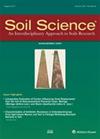利用一组协变量和特定地点数据预测瑞典森林土壤有机碳储量的空间分布
4区 农林科学
Q2 Agricultural and Biological Sciences
引用次数: 8
摘要
摘要景观中任何位置的土壤有机碳(SOC)储量状况受到不同尺度土壤状态因素的复杂相互作用,并调节多种过程,导致土壤充当碳的净汇或净源。森林景观具有高度的空间变异性,与影响整体景观的驱动因素相比,土壤有机碳储量的关键驱动因素可能是特定于子区域的。因此,与覆盖整个区域的单一模型(全球模型)相比,单独校准共同覆盖目标区域的子区域(局部模型)模型可能导致不同的预测精度和SOC库存驱动因素。因此,本研究的目标是:(1)评估全球和本地模型在预测瑞典森林腐殖质层、矿质土和总有机碳储量方面的差异;(2)确定有机碳储量预测的关键因素及其影响规模。我们使用瑞典国家森林土壤调查(NFSI)数据库和数字土壤制图方法,使用随机森林模型对瑞典北部、中部和南部(本地模型)和整个瑞典(全球模型)进行了本地校准,以评估预测效果。模型的建立考虑了(1)仅考虑在NFSI期间在样地上记录的站点特征,(2)协变量组(遥感、历史土地利用数据等)和(3)站点特征和主要由遥感数据组成的协变量组。局部模型对独立验证数据进行测试后的SOC库存预测通常更有效。将协变量组与NFSI数据一起使用表明,这些协变量具有有限的预测强度,但来自NFSI的特定地点协变量对SOC股票显示出更好的解释强度。影响腐殖质层、矿质土(0-50 cm)和总soc存量的最重要协变量与场地特征协变量相关,包括土壤水分等级、植被类型、土壤类型和土壤质地。本研究表明,局部校准有可能提高预测精度,这将取决于可用协变量的类型。本文章由计算机程序翻译,如有差异,请以英文原文为准。
Predicting the spatial distribution of soil organic carbon stock in Swedish forests using a group of covariates and site-specific data
Abstract. The status of the soil organic carbon (SOC) stock at any position in the landscape is subject to a complex interplay of soil state factors operating at different scales and
regulating multiple processes resulting either in soils acting as a net sink or net source of carbon. Forest landscapes are characterized by high spatial variability, and key drivers of SOC stock might be specific for sub-areas compared to those influencing the whole landscape. Consequently, separately calibrating models for sub-areas (local models) that collectively cover a target area can result in different prediction accuracy and SOC stock drivers compared to a single model (global model) that covers the whole area. The goal of this study was therefore to (1) assess how global and local models differ in predicting the humus layer, mineral soil, and total SOC stock in Swedish forests and (2) identify the key factors for SOC stock prediction and their scale of influence. We used the Swedish National Forest Soil Inventory (NFSI) database and a
digital soil mapping approach to evaluate the prediction performance using
random forest models calibrated locally for the northern, central, and
southern Sweden (local models) and for the whole of Sweden (global model).
Models were built by considering (1) only site characteristics which are
recorded on the plot during the NFSI, (2) the group of covariates (remote sensing, historical land use data, etc.) and (3) both site characteristics and group of covariates consisting mostly of remote sensing data. Local models were generally more effective for predicting SOC stock after
testing on independent validation data. Using the group of covariates
together with NFSI data indicated that such covariates have limited
predictive strength but that site-specific covariates from the NFSI showed
better explanatory strength for SOC stocks. The most important covariates
that influence the humus layer, mineral soil (0–50 cm), and total SOC
stock were related to the site-characteristic covariates and include the
soil moisture class, vegetation type, soil type, and soil texture. This study showed that local calibration has the potential to improve prediction
accuracy, which will vary depending on the type of available covariates.
求助全文
通过发布文献求助,成功后即可免费获取论文全文。
去求助
来源期刊

Soil Science
农林科学-土壤科学
CiteScore
2.70
自引率
0.00%
发文量
0
审稿时长
4.4 months
期刊介绍:
Cessation.Soil Science satisfies the professional needs of all scientists and laboratory personnel involved in soil and plant research by publishing primary research reports and critical reviews of basic and applied soil science, especially as it relates to soil and plant studies and general environmental soil science.
Each month, Soil Science presents authoritative research articles from an impressive array of discipline: soil chemistry and biochemistry, physics, fertility and nutrition, soil genesis and morphology, soil microbiology and mineralogy. Of immediate relevance to soil scientists-both industrial and academic-this unique publication also has long-range value for agronomists and environmental scientists.
 求助内容:
求助内容: 应助结果提醒方式:
应助结果提醒方式:


